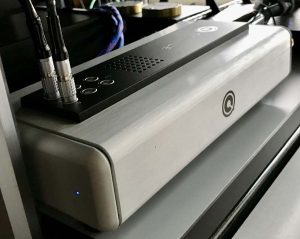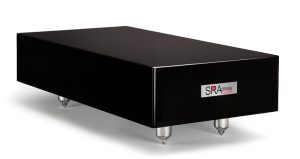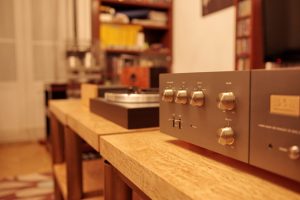Premier
Divine Acoustics is a Polish specialized company, founded in 2003 by Piotr Galkowski. It’s core business are loudspeakers, but the lineup also includes an anti-vibration platform, anti-vibration feet and loudspeaker cables. Divine Acoustics products are in-house developments, significantly different from other products of those kinds available on the market. We are Premier testing its latest Galileo anti-vibration feet.
Sometimes exceptional things are created by accident. Such was the case with Divine Acoustics' Kepler anti-vibration feet, introduced in 2018 (HERE). As their designer, Mr. Piotr Gałkowski, said, they were developed when he was working on decoupling the tweeter in his speakers; and the speakers were Divine's main products. During one of the tests, he put these anti-vibration elements under the whole speakers and, in his words, "that’s how it all started."
From the very beginning, the Keplers were designs significantly different from any other such product I know. They featured artificial rubies as decoupling elements, arranged in the shape of a pyramid on a ceramic base. The feet could be adjusted in terms of their height and were primarily mainly for loudspeakers, although their effect on electronics was equally significant. It took Mr. Piotr as long as five years to design and make the feet, which he himself says are a level, or maybe even two level, better than the initial project. These are the most complex designs of their kind that I know of, and some of the nicest anti-vibration components I've seen in my life.
A few simple words…
PIOTR GAŁKOWSKI, owner, designer
Where does the height adjustment come from in Galileo? The height adjustment came from thinking about how resonances are distributed in the equipment. I'm a graduate of construction engineering, so this is basic information for me. The heavier something is, the lower its own resonance. That is—it vibrates differently. Following this line of thought, I considered what an anti-vibration foot should look like, which will be fully utilized in a set with a 10 kg device, as well as 20 and 30.
As it turned out, the variable that most affects the fit of the feet to the resonances of the device is their height. The internal construction is such, as if the Galileo were several times taller, but thanks to several solutions it could be mechanically "folded" to the actual size.
Since we are turning the feet, we do not want our expensive equipment to get scratched from underneath. That's why the pressed-down foot works in such a way that its top plane does not move, it stays in place. Having Galileo under a player or amplifier, we don't have to lift it every time we adjust the height of the foot to the device. First, we position it so we can see the scale and then turn the top flange. And since we have a zero marker on the front, we know the exact position each foot is in. Thanks to the two scales, top and bottom, the adjustment can be very precise.
To make it all work and to make operating the feet a pleasant experience, it was necessary to make the parts with very low tolerances—that is, very precise. In many places accuracies are down to five hundredths of a mm. For example, all the stones I use for surface decoupling are measured and selected, all the damping layers are also measured before assembly.
Galileo is an extension of Kepler design. I made the body from PMMA cast acrylic—similar to what used to be used for fighter aircraft canopies. One of its properties is that it does not age over time, and even decades from now it will look identical to how it looks now. It takes two and a half hours to make the acrylic parts for one foot and they are laser cut. If these were metal parts, they would cost many times more and require several times more work, and the results would not be better at all.
There are damping layers inside with layers grouped in packages. One turns the middle element, and the core-screw is lubricated with a copper-based grease selected by me - that's why it has such a different appearance. It's curious that you can hear the differences between the lubricants, that is, their viscosity and consistency.
The vibration, which is initially dampened at the top, analogous to the Kepler, passes through the core to the bottom, descends almost to the very bottom of the foot, passes through the rubies, then returns to the top and spreads over the disc in the middle part of the foot. This disc is placed on top of more rubies and damping packs. All the elements require some slack to work together, and at the same time the whole structure must be rigid and stable—it was very difficult to achieve.
It took me four months to design the inner component. The screws are distributed around the perimeter according to the "golden ratio" and have different heights. It turned out that the height at which they are screwed in has a huge impact on the sound, and it had to be tuned, "by ear." Then I had to design a jig for this, which would ensure that I could make successive copies with a precision of two hundredths of a millimeter. People will probably say that I am "crazy," but you can hear it.
Each foot features 200 components, 26 types of screws, from M2 to M10. More than twenty prototypes were built before I could fit everything into a housing so that it would work perfectly smoothly. A lot of things that look simple had to be solved, and I spent days on each of them. For example, the top lock that stops turning.
From the top and bottom the feet are finished with wood. I searched for a long time for the right type and finally found wood that played well with Galileo. And since it did, I decided to use it also in the Kepler in the new Evolution version. What kind of wood is it? I'd like to leave that to myself.
In addition to height adjustment, additionally Galileo should be spaced in a properly "broken" triangle. I did a lot of related tests when designing the anti-vibration platform. One should avoid isosceles triangles! When you move one foot by a few cm, even though the changes in accelerometer measurements seem small, in sound they are significant. And there is a lot more "riding" on these micro changes than we can imagine.
I use only natural materials as damping layers in my anti-vibration feet. I also do not use balls - with all due respect to the feet, which are in the "High Fidelity" system, nor do I use zircons, only rubies. Since there is a difference of almost a class between these materials on the Mohs hardness scale, the difference in their mechanical interaction must also be very large.
Both stones—zirconia and ruby—are produced artificially, but ruby is made from elements that in nature naturally combine. The elements that make up zirconia, on the other hand, do not naturally combine in nature, they have to be forced to do so. And that's what matters. OK, acrylic is also an artificial material. But the acrylic in Galileo is only an element that is like a frame for the damping elements, it itself participates very little.
Currently I work on an anti-vibration platform decoupled from the ground using Galileo feet,
in which the tops are separated from each other by Keplers. There are two tops in it, and each top is made up of eight layers of the wood I used in the feet and the HDF and MDF boards. I went so far in my variation that I listened to which way the HDF board needs to be placed, as it vibrates differently with the laminate laid up and down.
The platform will also be adjustable for the weight of the unit. The adjustment is easy to use, a bit like a knob on an amplifier that adjusts the volume. Interestingly, when we place devices with metal enclosures on the platform we should adjust Galileo differently than for the devices with housings featuring wood. Devices with different ratios also behave differently—it's simply mechanics.
I am in the process of studying how shapes affect vibrations. In the measurements, you can see where to support a chassis or top, and it always arranges itself in a triangle. And it's not like one vertex is always in the front, two in the back or vice versa, but it's always an out-of-form triangle, with vertices in places depending on the shape of the device or countertop in question. Variations of 2-3 mm in the size of the platform top also affect the sound and the location of the support. No matter how crazy this seems—it is also evident in measurements. That's why I don't think the platform can have any dimensions but rather specific ones.
Let me add that the platform will be grounded. One of the layers is a steel mesh and its grounding has a huge impact on the sound. I hope that the new platform will be ready by the end of the year and that High Fidelity readers will be the first to see it.
Galileo Anti-Vibration Feet are among the best constructed anti-vibration components I know of; they are also among the most complex ones. That doesn't stop them from looking great. When I first saw them in a photo I knew it would be something special—after a while you get a feel for such things. But when I saw them in person, when I took them in hand and tried the height adjustment, my respect for their designer grew even more.
At the same time, these are some of the larger feet I've tested, next to the, also excellent, Pro Audio Bono CERAMIC 80 SN HERE feet. Their diameter ϕ is 85 mm and they are 47 mm high when fully folded, or 56 mm when cranked to full height. Each consists—when viewed from the outside—of two elements: a base and a twisted top. The perimeter of both is marked with precise graduations so that we can make our own tests. Mr. Piotr told me that on his website he will post a table with suggested settings for devices of a particular weight and construction. This will make the job a lot easier.
Adjusting the foot is smooth and simply pleasant - it's like turning the volume knob of a very expensive amplifier. This is helped by the shape and texture of the upper and lower mothballed orifices. There is also a third, thin one near the lower edge of the top element. It is with its help that we will be able to conveniently adjust the height of the feet when the devices are already placed on them. Galileo are constructed in such a way that under load their top plate does not move, only the flange - a cool solution.
SOUND
HOW WE LISTENED
Divine Acoustics' anti-vibration feet were tested in a High Fidelity reference system. I always test the anti-vibration feet in my system in the same way - under the signal source, sometimes assisted by other devices. This time I tested them under the Ayon Audio CD-35 HF SACD player.
During the test I move the player, its connections must be flexible. I use Crystal Cable Absolute Dream interconnects in such cases, and the player is powered by Harmonix X-DC350M2R Improved-Version cable. The comparison consisted of listening to the same piece of music (2 minutes long) on the reference feet and transferring it to the tested feet. The reference and test feet stood on the top of a Finite Elemente Pagode Edition Mk II carbon table top.
Mr. Piotr suggested that I start listening to my Ayon Audio player by cranking the feet two turns up - that's four pitches on the bottom flange. I tried a slightly different setting and must say that this was the best. The general rule of thumb is this: a foot set lower shifts the timbre slightly toward the low frequencies, and higher shifts it upward.
Recordings Used a selection
The Oscar Peterson Trio, We Get Request, Verve/Lasting Impression Music LIM K2HD 032, K2HD Mastering, "24 Gold Direct-from-Master Edition UDM", Master CD-R (1964/2009).
Andrzej Kurylewicz Quintet, Go Right, Polskie Nagrania "Muza"/Warner Music Poland 4648809, "Polish Jazz | vol. 0", Master CD-R (1963/2016); HERE
King Crimson, In The Court Of The Crimson King (An Observation By King ... “50th Anniversary Box Set", 3 x K2HD UHQCD + Blu-ray (1969/2019).
Laurie Anderson, Bright Red, Warner Bros. 9362-45534-2, CD (1994).
Jean Michel Jarre, Oxygene, Disques Dreyfus/Mobile Fidelity Sound Lab UDCD 613, "Original Master Recording," Gold-CD (1976/1994).
You know how it is, theoretically everything is clear, we understand what a product is about, we appreciate the commitment of its designer, and still somewhere deep in our brain there is a doubt. This is how we are constructed, and unless we are brainwashed and part of some sect (it can be any sect—religious, financial, political, social, etc.), we must have doubts in order to survive.
For me, however, this is quite an uncomfortable situation, because on the one hand, doubts should guide me amidst the multitude of products available on the audio market, and on the other hand I must, after all, also be clear about the specifics, because I am sharing my insights with you and I want them to be as certain as possible. And that is why the first several minutes with Galileo's feet were so stressful for me. I know, value and respect Mr. Gałkowsky, and I am impressed with his products. I also realize that adjusting the resonance of the foot system must affect the sound, because resonances do. But...
It so happened that in this particular case the doubt I’ve mentioned could quietly curl up and go to sleep, waiting for the next opportunity. The first thing I did when I sat down in front of the system featuring the Divine Acoustics feet under the Ayon Audio CD-35 HF Edition player, was to check not the feet themselves, but how the performance is really affected by their height, that is, how changing resonances distribution of the system influences the sound. It turned out, that it did, significantly.
Galileo's designer mentioned that the rule of thumb is: lower feet = lower sound, and vice versa. And indeed it was true—that was the effect I could hear clearly and repeatably. But it did it in a different way from what I had imagined. The timbre of the sound changed with the twisting or turning of the feet, but it affected more the "presence" of the instruments operating in a given band, their energy, and less the classically understood timbre. The feet, unscrewed by just one turn, showed that the leader's piano on The Oscar Peterson Trio's We Get Request was the most important instrument on the stage, or so it seemed, at least. So it seemed it was the "right" change, it was ultimately the leader, but after all, that's not what the trio was about, but rather the consonance, the "interplay."
Moving up to four turns shifted my attention to the percussion cymbals and double bass—and I was listening to the track Quiet Nights of Quiet Stars (Corcovado), in which it starts very high and only goes lower after a while. However, it wasn't as if the top or bottom had suddenly arrived. Apparently, that's how I could perceive it, and I understand that some readers will take these changes that way—and that's fine. But the shift I'm talking about was about something deeper than timbre itself, it was about how the sound was built, not just whether something was lighter or darker in it.
And the feet themselves? Moving the player from the Galileo to the Franc Audio Accessory feet, after all excellent and used by me for years, produced a lower sound, as if I had lowered the Divine Acoustics feet, but also a less resolving sound. It was as if some of the information was extinguished. The presentation was "more serious," at least at first glance, but also less dynamic and not as energetic as before. With Galileo the performance was simply more interesting and more natural. Not that there was anything wrong with the feet on the Ayon's special version—if I hadn't had a comparison, I would have been happy with them. But the comparison was there, and it was clear that the tested feet were much better.
The thing I noticed right at the beginning of the listening was the kind of silkiness I got with them. It's not about softening the attack, but precisely about saturating it with more sound (harmonics?). That's why the trio's album sounded even deeper, even stronger, going in the direction we go when we swap the Compact Disc version of a given recording for a Super Audio CD.
This also came out momentarily with the Go Right album by the Andrzej Kurylewicz Quintet. The switch to Galileo unleashed so many new layers in the music that I couldn't believe it. I know it's the micro-information, it's what builds the sound the way it does, but I didn’t hear it as adding detail or subtleties. I would even say that at first it may have seemed that there was less detail. Until I realized that they were no longer needed per se, because the sound with the feet was wider, deeper, bigger.
The version of the CD I'm talking about is the Master CD-R, a gold disc burned for me by the remastering engineer of this material, Jacek Gawłowski, in his studio, and it sounds excellent. Anyway, the regular CD is great too. This material was known until that release in mono, and it truly delights in stereo version. The tested feet made me fell as if there was more of everything in it. And everything was clearer. Not only on the level of sound information, but musically as well.
For years I wondered why the producers muted this track at the end of the fifth minute, just when Jan Ptaszyn Wroblewski enters on saxophone with a solo. Finally I realized that it most likely didn't appeal to the producers, or perhaps to the musician himself, because it slightly deviates in character from the rest of the track. If I had the Galileo feet in my system years ago and had this system, I would have known that right away.
The interesting thing is that the feet in question do not impose their character. Or if they do, I am unable to pinpoint it. Because the sound changed timbrally in different ways, depending on what kind of music I was listening to. While with Peterson and Kurylewicz the sound got warmer and more velvety, listening to In The Court Of The Crimson King (An Observation By King Crimson by King Crimson as remixed by Steven Wilson on the 50th anniversary of its release I got a different representation of the material. This is the last remix of this material before the era of artificial intelligence, and an excellent one at that.
Its sound with Galileo was darker dark and dense. Gone was the slight emphasis—really slight, but still—of the higher frequencies. Everything with them was dense and saturated. The stereo base was wide, and instruments were superbly differentiated on stage in how they sounded and where they were placed. Unlike usual, this involved a subjective warming of the sound rather than a brightening. I had no doubt that the Mellotron was clearer, but also deeper in timbre, or that the kick drum hit hard and fast, yet was not overly contoured.
There is a lot of everything with these feet. And it's all brilliantly integrated. And this integration leads to a better emotional connection with the musical material. I really had the feeling at times that I was listening to some albums for the first time, or at least after a long time. You probably experience that too, that once you have listened to a particular album one too many times and need a break from it, coming back after a long time leave in owe because of how amazed you are again with it. I had the same experience listening to music with Galileo's feet.
Exactly like I did with Laurie Anderson's Bright Red album from 1994. It's great music and I used to listen to this disc more often than necessary. No longer comparing it to anything, I listened to these recordings with the player on test feet. The intro came out beautifully with the rhythm played on the snare drum, with occasional hits on the cymbals and a strong kick drum. But I also immediately heard something I had forgotten, namely, that this is quite brightly recorded material. There is a beautiful bass extension, a strong midrange, but the treble are a bit too "tense," not enough plasticity in them.
And yet I mentioned "velvety sound," and subjective warming up of the sound, right? Apparently so, but—as it turns out—the feet don't bring these features to the sound, but help the plasticity, as it is probably the most important feature, to free itself. Because Jean Michel Jarre from the Oxygene album, released in 1994 by Mobile Fidelity Sound Lab on a gold disc, played in an open way, with a stronger upper midrange than I remembered. And at the same time it was still great playing, with multiple layers, with a wide tonal range, very resolving.
So if you're looking for feet that will change all your recordings in one direction, this is not the way to go.
Divine Acoustics vs Pro Audio Bono
I usually don't do it, because it doesn't make much sense and it's a waste of my time, but this time I compared the sound of the tested feet to that of other ones. And that's because I've been using the → PAB Ceramic 70 Uni-Foot HERE (PL) model under my player for a long time. And secondly, it seems to me that we are dealing with sound of the same class, although different.
With the PAB feet sound is more massive, stronger, denser. The attack of the sound is not emphasized with them, it's very natural playing, but the sustain is tight with them, concentrated in a short interval. This results in a very dynamic, but also resolving sound. The Uni-Foots convey the sound unambiguously, wide and deep. Listened to immediately afterwards, the Galileo offer a presentation that is slightly more withdrawn within the stage that we "enter" in a softer way. The bass is deep with them, but it's the PABs that generate more energy in it.
The reference feet show the foreground close, in an almost tangible way. I like this kind of presentation because it gives me the illusion of "presence" of the musicians, normally provided by sight. In audio, since about 80% of the information about space that we acquire just by using our eyes disappears, it has to be compensated somehow—in my opinion, "tangibility" is one of the best ways. And the Uni-Foot feet provide that.
But Divine Acoustics feet, doing it differently, lead to the same results. Their sound is more vivid and less "here and now." They create the illusion of "presence" through an incredibly saturated sound. Soft, almost velvety, and still perfectly controlled and dynamic. The PABs are more unambiguous in bringing out rhythm and in showing the bodies of the instruments. Galileo, on the other hand, fill and saturate the sound more strongly.
WHICH ONES ARE BETTER?
That will depend entirely on the system in question and on you, both designs are excellent and both will be part of the High Fidelity reference system from now on. The Galileo feet are more versatile, as they can be tuned to a specific device. On the other hand, however, the PAB Ceramic 70 Uni-Foots play perfectly well without any adjustments, so they can be easier to use and used where you don't want to bother with adjustments. As usual, it's a matter of what we're looking for. After all, both sets of feet are excellent, and are probably the best designs of their kind that I know of.
Summary
Wiciu, member of the Krakow Sonic Society, during a meeting where we hosted Janusz and Robert Sikora at Julek Soja's place, along with a J.Sikora Reference turntable, said something that perfectly fit the situation. After a brief description of the sound, he suddenly gathered himself and, in one breath, threw in that he was proud that products of Polish audio company are so unbelievably good, that he could experience it and that the world could learn many things from us. Amen! - I think so, too. And this is true both when looking at the tested set and the set of Pro Audio Bono feet.
Because the Divine Acoustics Galileo anti-vibration feet are simply excellent. Their mechanical design, the idea behind it, but also the workmanship are for me a model of what such a product should look like. They bring out depth, velvety profundity, plasticity, vividness, and energy—everything a recording has to offer. At the same time, they are extremely differentiating, because they do not impose this character on the recordings. If the latter sound brighter, they will be reproduced that way. If the compression on them flattens the sound, Galileo will not "remaster" that.
They will, however, do something else: they will deepen the presentation in such a way that it will seem to us that we are hearing much more than before, even with good anti-vibration feet, not to mention ones offered with components. And this "more" will be not achieved by greater detail or selectivity, but by more "sound in sound." It's simply resolution. And that's what these feet are: a machine for unleashing it in music. That's why, from us, they receive our most important award, the Gold Fingerprint and the High Fidelity Reference logo.
This test has been provided under the guidelines adopted by the Association of International Audiophile Publications, an international audio press association concerned with ethical and professional standards in our industry; High Fidelity is a founding member. You can find more about the association and its constituent titles HERE.
Divine Acoustics
Price (when reviewed): 700 EUR/3 pieces set
ul. Słowackiego 10B/10
46-040 Ozimek ⸜ POLSKA
MADE IN POLAND
Provided for test by Divine Acoustics
text WOJCIECH PACUŁA
translation Marek Dyba
images High Fidelity


















































